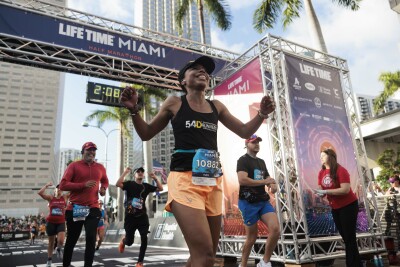From the community 5K to some of the nation’s largest road and trail races, the competition for participants is heavier than ever, especially as the nation’s racing scene continues climbing its way back from pandemic-era doldrums. That reality doesn’t escape Mike Melley, VP–event operations at Life Time.
While certain ingredients remain table stakes in today’s racing environment – a well-constructed course, accurate results, stocked aid stations, ample volunteers and a seamless packet pickup experience among them – Melley understands the need for more and his team has worked to add extra spice to Life Time’s events.
“We want to stand out and give people a different experience,” Melley says. “We want to take a core product and elevate it one more step.”
At massive Life Time-owned events such as the 20,000-plus runner Miami Marathon & Half and the Chicago Half as well as iconic races like the Leadville 100, Life Time continues experimenting with different ways to create something more festive and enticing, more engaging and appealing for athletes and sponsors alike. While the efforts are helping Life Time capture results, the company’s events also provide smaller events, including those hosted by running stores across the U.S., an intriguing playbook to study.
Go beyond the blasé packet pickup.
Some might describe the traditional race expo as part packet pickup and part fitness-oriented flea market. Life Time, however, is challenging that paradigm at some of its events. Its “pre-race party” for the Chicago Half in late September, for instance, took place at North America’s largest indoor-outdoor heliport and featured live music, food trucks and photo opportunities alongside sweeping views of the Chicago skyline.
Making it local: While renting out a heliport is unlikely to make sense for a 500-person community 5K, local races can still create a more distinctive and dynamic packet pickup event to elevate participants’ experience. Consider adding food, drink, live music or yard games. Or a photo booth. Or a panel discussion about running after 50. Or an exciting video tour of the course. Or posters featuring factoids and stories about landmarks along the course route. Cook up ways to educate, entertain and engage participants.
Involve sponsors in more dynamic ways.
The competition race organizers face isn’t only for participants; it’s also for sponsors who want to capture some ROI for their investment. For Life Time, it’s sparked some interesting sponsor activations.
At the 2023 Life Time Miami Marathon & Half, clothing brand Ten Thousand created the “Run Strong” zone at the 10K mark. There, Ten Thousand encouraged runners to drop and give them push-ups and burpees before donating $1 to the Life Time Foundation for each rep counted. The setup gave Ten Thousand some added buzz, enlivened the course and generated positive vibes all around.
Melley says other sponsors have stepped up to host water stations, which saves event management time, resources and manpower. Others have created spots on the course featuring branded arches, live music or giveaways.
Making it local: Running stores and race directors might explore creative ideas that resonate with participants and heighten sponsors’ visibility. Maybe the sponsoring bakery provides a custom cookie at the finish line in lieu of – or in addition to – a finisher’s medal. Or the local boxing gym performs live demos and plays music from “Rocky” a mile from the finish line. Or the race spotlights a different local charity at each mile mark with custom designed signage and other themed activations.
Broadcast the race.
Life Time has used Instagram Reels to provide live look-ins at races like the Leadville 100 as well as footage shot from a helicopter to share post-race summaries on YouTube.
Melley says athletes and spectators alike hold high expectations for coverage, specifically live coverage, which demands equipment, money and talent. However, the payoff for broadcasting a race, even on social media, can be worth it.
“If you do it and do it well, the number of impressions and feedback you can get back is pretty amazing,” Melley says, adding that video can ignite “a bit of FOMO” (fear of missing out). “There might be someone who never thought of running 100 miles who sees it and now says, ‘Huh? Maybe?’”
Making it local: Broadcasting the race or sharing a lively summary video on social media can attract eyeballs and attention, potentially spurring a race’s profile and participation numbers.
Consider creating videos – either live or edited – featuring interviews with race winners, the race director, volunteers or other participants displaying some energy and flair. Offering more coverage, a unique perspective or live commentary on how the race is unfolding can generate interest that sticks.







